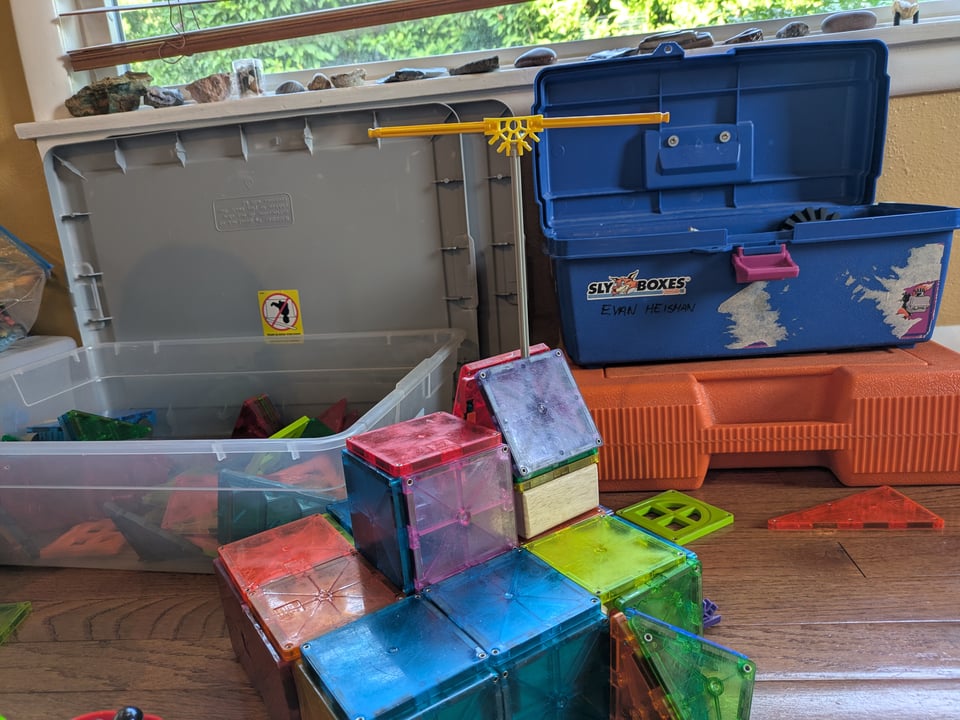Bird of Passage: September 2025
Our backyard has a unique bird-related feature...
Recently my son, who just started second grade, had a bunch of different building toys spread out on the living room floor and declared that he was going to build an ornithology lab. The first thing it needed, he decided, was a radio antenna. “You know, for Motus,” he said.

He, uh, possibly knows a lot more about methods for tracking birds than the average seven-year-old. But something I haven’t mentioned here before is that we actually have a Motus station in our backyard. And it was not my doing.
A quick review: Motus is an automated radio telemetry system. You put a tiny radio transmitter on a bird (or other critter), and any time it passes within range of one of numerous receiver stations dotted across the landscape, it provides a datapoint for researchers: this bird was in the vicinity of this location at this date and time. It’s one of the ways we have of following birds on their long-distance migrations. (There’s a whole chapter about it in my book!)
Motus stations are supposed to be relatively easy and inexpensive to set up. They’re found on the roofs of park visitor centers, sponsored by local Audubon chapters, things like that. But I don’t know of any other Motus stations that are located in someone’s personal backyard, operated by a private individual just for the heck of it.
You see, my spouse is a ham radio enthusiast. (Other spouses of hams out there are wincing sympathetically. If you know, you know.) When he learned about Motus (from me talking about it all the time while researching my book), he was intrigued and looked up the Motus network’s website, which includes instructions for setting up a station.
When he told me was pretty sure he had most of the components to build one sitting around in the basement, I didn’t take him seriously at first. But he actually built it (egged on a bit by a local ornithologist acquaintance of ours), got it connected to the network, and now if you go to the map of stations on the Motus website, you can find a yellow dot in Walla Walla, Washington.
No, we have not picked up any passing birds yet. I’m not surprised by this, considering our location (no major migratory corridor here) and the fact that as far as I know, no one is tagging birds anywhere near us. But if any birds with Motus tags do happen to pass overhead this fall, we’ll know about it—and I’ll feel just a little more connected to the amazing phenomenon of migration.
Words About Birds
Want to learn even more about Motus? Here’s a recent story on it from High Country News, focusing on work being done in Montana to track migrating Sprague’s Pipits and learn more about the threats they face.
In other bird news: I was impressed by the scope of this sweeping new analysis of how light pollution is affecting birdsong. Using backyard recordings that captured the songs of 500 bird species across multiple continents, the researchers determined that exposure to artificial light is causing birds worldwide to start singing earlier and keep singing later, adding almost an hour to birds’ days on average.
I also liked this story about how surprised scientists are by new data on Streaked Shearwaters’ pooping habits. Apparently these seabirds poop all the dang time, like five times an hour, and no one is sure why! My favorite part is that the researcher who first mounted backwards-pointing cameras on the birds’ undersides was hoping to study their leg movements as they took off from the water, but changed his focus when he ended up with lots and lots of video of birds defecating instead.
Finally, it seems that “sex reversal” may be more common birds in birds than anyone has realized. Australian ornithologists examined the reproductive organs and tested the chromosomes of wild birds that died at Queensland wildlife hospitals. Amazingly, they found that 3% to 6% of the birds, depending on the species, had reproductive organs that didn’t match their sex chromosomes. They even found a genetically male kookaburra with an enlarged oviduct that suggested it had recently laid an egg!
Book Recommendation of the Month
The Feather Detective: Mystery, Mayhem, and the Magnificent Life of Roxie Laybourne by Chris Sweeney. I LOVED this book! It’s a biography of the woman who founded the Smithsonian’s Feather Identification Lab, which identifies bird species involved in airplane strikes. Roxie Laybourne basically invented the science of feather identification while smashing through barriers as a woman scientist in the mid-twentieth century. A quirky, badass woman scientist AND arcane tales of the development of ornithological methods? Yes, please!
Miscellany
I enjoyed appearing on the podcast Coast Range Radio to chat about why understanding bird migration matters for conservation! This independent podcast and radio show, produced by a climate justice organizer and rural Oregonian named Michael Gaskill, focuses on the connections between Pacific Northwest forests, social justice, and the climate crisis.
Also: I can’t believe it but I’m already booking speaking engagements for next spring… if you’re looking for a fun, engaging keynote speaker for your bird-related event, maybe drop me a line!
As always, feel free to leave a comment or reply to this newsletter via email! See you next month.
Add a comment: